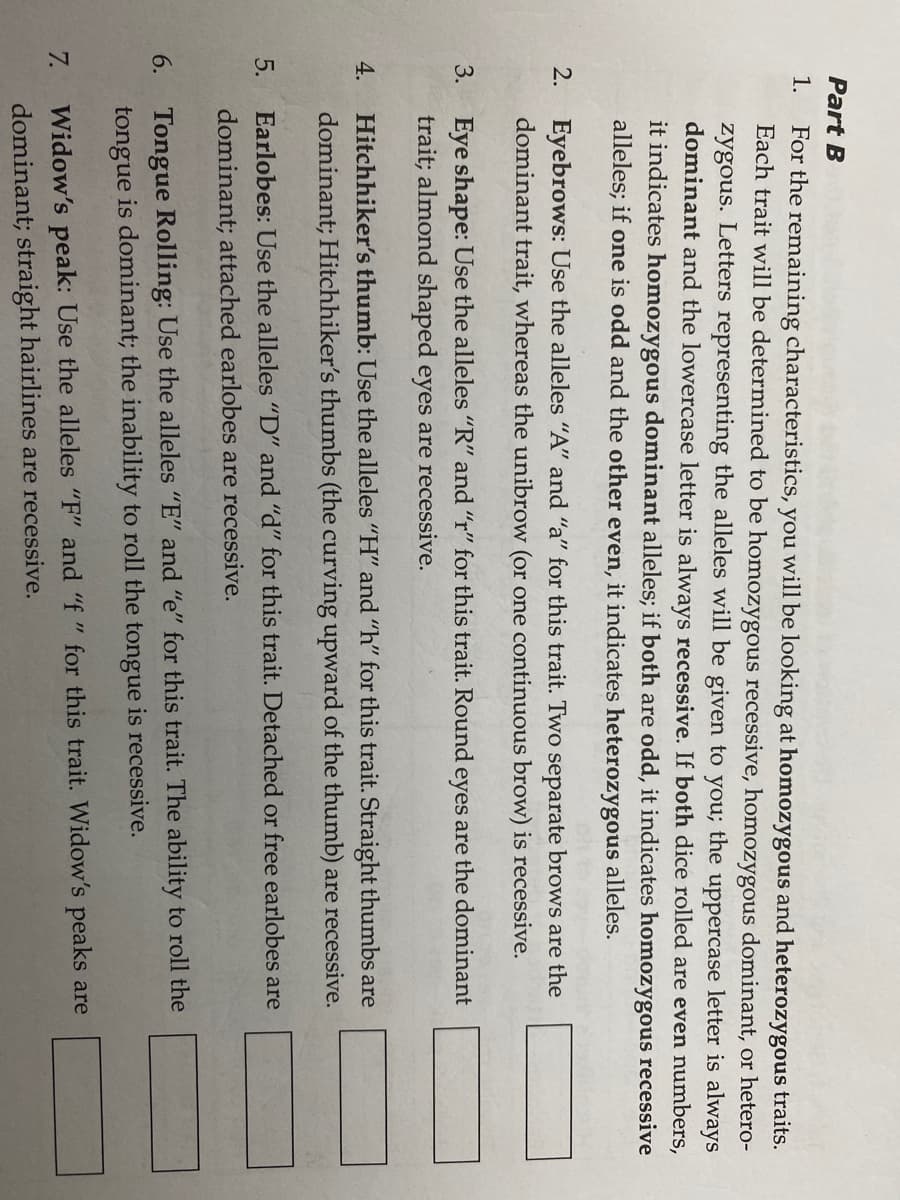Part B 1. For the remaining characteristics, you will be looking at homozygous and heterozygous traits. Each trait will be determined to be homozygous recessive, homozygous dominant, or hetero- zygous. Letters representing the alleles will be given to you; the uppercase letter is always dominant and the lowercase letter is always recessive. If both dice rolled are even numbers, it indicates homozygous dominant alleles; if both are odd, it indicates homozygous recessive alleles; if one is odd and the other even, it indicates heterozygous alleles.
Part B 1. For the remaining characteristics, you will be looking at homozygous and heterozygous traits. Each trait will be determined to be homozygous recessive, homozygous dominant, or hetero- zygous. Letters representing the alleles will be given to you; the uppercase letter is always dominant and the lowercase letter is always recessive. If both dice rolled are even numbers, it indicates homozygous dominant alleles; if both are odd, it indicates homozygous recessive alleles; if one is odd and the other even, it indicates heterozygous alleles.
Human Anatomy & Physiology (11th Edition)
11th Edition
ISBN:9780134580999
Author:Elaine N. Marieb, Katja N. Hoehn
Publisher:Elaine N. Marieb, Katja N. Hoehn
Chapter1: The Human Body: An Orientation
Section: Chapter Questions
Problem 1RQ: The correct sequence of levels forming the structural hierarchy is A. (a) organ, organ system,...
Related questions
Topic Video
Question
100%

Transcribed Image Text:Part B
1.
For the remaining characteristics, you will be looking at homozygous and heterozygous traits.
Each trait will be determined to be homozygous recessive, homozygous dominant, or hetero-
zygous. Letters representing the alleles will be given to you; the uppercase letter is always
dominant and the lowercase letter is always recessive. If both dice rolled are even numbers,
it indicates homozygous dominant alleles; if both are odd, it indicates homozygous recessive
alleles; if one is odd and the other even, it indicates heterozygous alleles.
2. Eyebrows: Use the alleles "A" and "a" for this trait. Two separate brows are the
dominant trait, whereas the unibrow (or one continuous brow) is recessive.
3.
Eye shape: Use the alleles "R" and "r" for this trait. Round eyes are the dominant
trait; almond shaped eyes are recessive.
4.
Hitchhiker's thumb: Use the alleles "H" and "h" for this trait. Straight thumbs are
dominant; Hitchhiker's thumbs (the curving upward of the thumb) are recessive.
5.
Earlobes: Use the alleles "D" and "d" for this trait. Detached or free earlobes are
dominant; attached earlobes are recessive.
6. Tongue Rolling: Use the alleles "E" and "e" for this trait. The ability to roll the
tongue is dominant; the inability to roll the tongue is recessive.
7.
Widow's peak: Use the alleles "F" and "f " for this trait. Widow's peaks are
dominant; straight hairlines are recessive.
Expert Solution
This question has been solved!
Explore an expertly crafted, step-by-step solution for a thorough understanding of key concepts.
Step by step
Solved in 2 steps

Knowledge Booster
Learn more about
Need a deep-dive on the concept behind this application? Look no further. Learn more about this topic, biology and related others by exploring similar questions and additional content below.Recommended textbooks for you

Human Anatomy & Physiology (11th Edition)
Biology
ISBN:
9780134580999
Author:
Elaine N. Marieb, Katja N. Hoehn
Publisher:
PEARSON

Biology 2e
Biology
ISBN:
9781947172517
Author:
Matthew Douglas, Jung Choi, Mary Ann Clark
Publisher:
OpenStax

Anatomy & Physiology
Biology
ISBN:
9781259398629
Author:
McKinley, Michael P., O'loughlin, Valerie Dean, Bidle, Theresa Stouter
Publisher:
Mcgraw Hill Education,

Human Anatomy & Physiology (11th Edition)
Biology
ISBN:
9780134580999
Author:
Elaine N. Marieb, Katja N. Hoehn
Publisher:
PEARSON

Biology 2e
Biology
ISBN:
9781947172517
Author:
Matthew Douglas, Jung Choi, Mary Ann Clark
Publisher:
OpenStax

Anatomy & Physiology
Biology
ISBN:
9781259398629
Author:
McKinley, Michael P., O'loughlin, Valerie Dean, Bidle, Theresa Stouter
Publisher:
Mcgraw Hill Education,

Molecular Biology of the Cell (Sixth Edition)
Biology
ISBN:
9780815344322
Author:
Bruce Alberts, Alexander D. Johnson, Julian Lewis, David Morgan, Martin Raff, Keith Roberts, Peter Walter
Publisher:
W. W. Norton & Company

Laboratory Manual For Human Anatomy & Physiology
Biology
ISBN:
9781260159363
Author:
Martin, Terry R., Prentice-craver, Cynthia
Publisher:
McGraw-Hill Publishing Co.

Inquiry Into Life (16th Edition)
Biology
ISBN:
9781260231700
Author:
Sylvia S. Mader, Michael Windelspecht
Publisher:
McGraw Hill Education